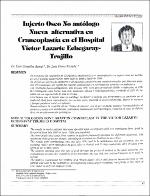| dc.contributor.author | González Asmat, Luis | |
| dc.contributor.author | Flores Estrada, Luis | |
| dc.date.accessioned | 2024-01-02T12:22:09Z | |
| dc.date.available | 2024-01-02T12:22:09Z | |
| dc.date.issued | 1994-06 | |
| dc.identifier.citation | Revista Médica del IPSS. 1994; 3(2). | es_PE |
| dc.identifier.uri | https://hdl.handle.net/20.500.12959/4879 | |
| dc.description.abstract | Se Presentan los resultados de 12 Pacientes intervenidos por craneoplastía con injerto óseo no autólogo, en el periodo comprendido entre julio de 1989 y junio de 1993.
Se utilizaron injertos de cadáveres o de pacientes anteriormente craniectomizados por diversos motivos. El tratamiento del injerto fue sencillo, consistiendo en esterilización estándar en autoclave.
Los resultados fueron halagadores, sólo un caso (8%) tuvo que ser retirado debido a infección, el 92% fue catalogado como bueno, han sido evaluados clínica y radiológicamente, contando el 25% de los casos con un seguimiento de más de 3 años.
Concluimos que el injerto óseo no autólogo, mediante el método que Proponemos se convierte en el material ideal para craneoplastia, por su bajo costo, sencillez en su Procedimiento, exento de rechazo y Porque puede ser usado en infantes.
Recomendamos la creación de un "Banco de huesos", con el que se puede ahorrar incomodidades al Paciente y costos a la institución, realizando tratamiento neuroquirúrgico y Plastia en caso de defecto óseo, en un solo momento quirúrgico. | es_PE |
| dc.description.abstract | The results in twelve patients that were operated upon cranioplasty with non-autologous bone graft in the Period from July 1989 to June 1993, are presented.
The bone grafts used came from corpses or Patients previously operated for different diagnosis. The treatment of the graft was simple, consisting in standard sterilization in autoclave.
The results were outstanding, only one case (8%) had to be withdrawn due an infection, the re maining (92%) were catalogued as good, after a clinical and X- Ray evaluation. 25% of cases were followed up to three years.
The authors conclude that this type of graft through the proposed method is the ideal material for cranioplasty, because the simplicity of the procedure, the low risk, low cost and because it be used in infants.
The authors recommend the creation of a "Bones Bank" which will prevent inconveniences to the Patient and costs to the institution, accomplishing neurosurgery treatment and plasty in the cases of bone defect in only one surgical event. | es_PE |
| dc.format | application/pdf | es_PE |
| dc.language.iso | spa | es_PE |
| dc.publisher | Seguro Social de Salud (EsSalud) | es_PE |
| dc.rights | info:eu-repo/semantics/openAccess | es_PE |
| dc.rights.uri | https://creativecommons.org/licenses/by-nc-sa/4.0/ | es_PE |
| dc.subject | Trasplante óseo | es_PE |
| dc.subject | Craneotomía | es_PE |
| dc.subject | Trasplante de Tejidos | es_PE |
| dc.title | Injerto óseo no autólogo nueva alternativa en Craneoplastía en el Hospital Víctor Lazarte Echegaray – Trujillo | es_PE |
| dc.title.alternative | Non autologous bone graft in craniopiasy in the victor Lazarte Echegaray Trujillo Hospital | es_PE |
| dc.type | info:eu-repo/semantics/article | es_PE |
| dc.subject.ocde | https://purl.org/pe-repo/ocde/ford#3.02.13 | es_PE |






